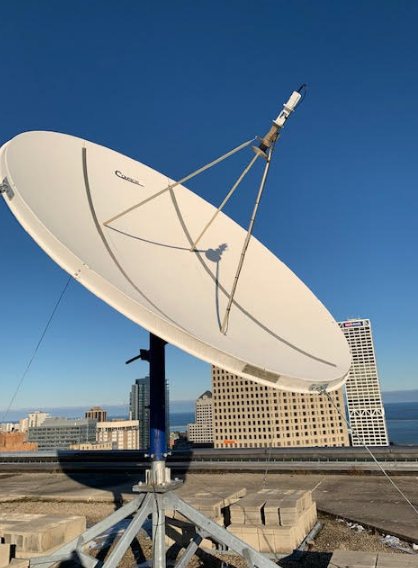The UHF band for satellite communication spans 300 MHz to 3 GHz, typically encompassing sub-bands like 400-420 MHz for military uses, 450-470 MHz for commercial radio, 800 MHz for emergency services, and 2.4-2.5 GHz for satellite internet and educational broadband.
Low Frequency (LF) Band
The Low Frequency band, which spans from 30 kHz to 300 kHz, performs roles that are all but identical to the UHF band used for satellite communications. Use of the LF band is to be found first and foremost in the maritime domain, where ships at sea communicate over long distances. The LF frequency range is particularly useful in the maritime context owing to its superior properties for long distance travel and for penetrating water, an ideal property for contacting ballistic-missile submarines running silent at extreme depth. The length of the waves in this frequency range oscillates between 1 and 10 kilometers, and HF signals, which have traditionally been chosen for shortwave communication, can travel hundreds of kilometers along the ground or in the troposphere.
The signals can, however, be refracted off the ionosphere or propagate along it in the E-region and the F-region, which spans roughly between 120 and 300 km above Earth’s surface, rendering transoceanic travel without satellites feasible. The United States Navy, for example, operates a VLF transmitter in Cutler, Maine that employs two antennas, each a mile long. The station, which functions in the LF band transmitting at a rate of 100 kilowatts, can broadcast reliably to submerged submarines in the North Atlantic. Such stations are power hungry, and low frequency radio stations generally require multiple megawatts of power to maintain signal strength and to burrow through the thick insulating blanket of warm, low-density ocean water up to 3,000 feet deep. By contrast, the UHF band spans between 300 MHz and 3 GHz, offers greater frequency and, hence, the use of smaller satellited and antenna.
The UHF band is primarily used in satellite communications, as the signals are well-matched for line-of-sight communication. Your computer uses UHF signals to communicate with wireless mice and keyboards, while televisions broadcast in the UHF range. UHF usage extends to the GPS in your car or your mobile phone, where a geosynchronous satellite is in constant communication with your UHF radio. In general, UHF satellite dishes are approximately 45 cm in diameter if you buy one for your house, whereas the Leifur Eriksson dish is massive by comparison. LF bands are also used as time signals and in radio navigation systems, such as the LORAN-C system of the 20th century. LORAN-C was an international navigation system consisting of 36 station pairs and covering every major seaway. The system was discontinued in 2010 and provided 100-nanosecond time-synchronization over hundreds of kilometers, an invaluable tool for aircraft carrier pilots and others.

High Frequency (HF) Band
The High Frequency band is a range between 3 MHz and 30 MHz and is well-known for its capability to provide long-distance communications. HF signals reflect from the ionosphere, and the central means of propagation called “skywave,” thus allowing speakers to transmit signals across land and sea without using any intermediate space technology. The HF band is widely used among international shortwave broadcasting as a cheap and effective means of international communication. Moreover, amateur radio users benefit from the HF band greatly, especially at times of extreme weather and natural disasters.
The HF band used to be the paramount technology for ships to communicate from sea to the coastal land and other ships. Although satellites and satellite phones provided a new means of communication, HF radios are still mandatory for all the maritime vessels and their crews. The HF band is still in use, as the sign can reach very far, as far as the skip distance of HF. It is impossible for the standard HF communication from point A to point B to be the most efficient means of communication due to the land area covered, but it can be further transmitted through a series of stops. On the other hand, HF radios only require a battery setup at either end to be ready for communication.
HF antennas are usually much larger than UHF antennas, but having a line of sight and a fairly precise alignment is required for UHF. HF radios are very robust and work well in very difficult environments. Although both devices are resistant to rain, humidity, and physical damage, HF radios are less prone to malfunction if occasionally dropped or thrown around. UHF is also very dependent on having a landline in the form of satellite technology, whereas the job of the HF band is highly networked. San Francisco Fire Department purchased several HF and UHF which they use as backups for long message and alert sending.
Very High Frequency (VHF) Band
Very High Frequency is the frequency band that ranges from 30 MHz to 300 MHz. This band is of an utmost importance for multiple communication systems as it provides the most balanced solutions in terms of both range and obstacle penetration. Even though the Ultra High Frequency is the most widely used frequency band for satellite communications, Very High Frequency is more commonly utilized for the purposes related to FM broadcasting, TV broadcasting, and two-way land mobile services.
One of the applications of the Very High Frequency is the FM radio broadcasting. The stations that operate within this frequency band transmit over dozens of kilometers, depending on terrain and the transmission power of a particular station. For instance, a typical FM station operates at several hundred watts for local coverage and tens of thousands of watts for the coverage of a surrounding area. This way, the transmitted signal is always of a high-quality allowing the broadcasting of music and high-fidelity audio.
Another application of the Very High Frequency is the television broadcasting. Prior to the broadcasting transition to digital, VHF 2-13 channels were used for TV broadcasting. The VHF signals could travel farther under similar circumstances to the UHF signals due to the propagation of VHF waves at larger distances at lower frequencies. Nevertheless, after the implementation of the digital broadcasting, a significantly larger number of stations are now using UHF bands instead of the Very High Frequency one due to smaller spectrum and higher capacity to carry data.
Lastly, the Very High Frequency is widely used in VHF maritime communications for ship-to-ship and ship-to-shore communications necessary for navigation, safety, and other procedures. For example, the VHF frequency at 156.8 MHz is the international calling and safety frequency. Another essential means of aviation communication is the VHF band. It is used by the air traffic control to ensure safe and efficient communication between the pilots and the control facilities on the ground. The most common of the VHF frequency range for this type of communications is 118 MHz-137 MHz.

Ultra High Frequency (UHF) Band
Ultra High Frequency ranges from 300 MHz to 3 GHz and provides a unique spectrum for a variety of applications. The UHF band is a popular choice for a variety of applications, particularly in satellite communications. Between 300 MHz and 3 GHz, it features higher frequencies allowing for smaller, more compact antennas as well as greatly improved capacity to convey data over the air. Satellite communications make extensive use of the UHF band as it is particularly functional in various Mobile Satellite Service applications. It includes the use of GPS devices, mobile phones, and portable media devices. In the Global Positioning System GPS, for instance, the L1 signal operates at 1.57542 GHz, and at 1.2276 GHz,. It achieves appropriate balance, offering wide coverage while avoiding too much attenuation through the Earth’s atmosphere.
Furthermore, the UHF band is very important in television services. Digital television DTV channels can be found within the UHF band. The UHF band’s capacity to support high-definition video and multiple channel programming is particularly useful as such programming can be easily accommodated on a portion of the spectrum that previously supported one “analog” channel. As such, the bandwidth usage becomes significantly more efficient, and the television picture clearness and sound quality significantly increases. In regard to telecommunication, UHF is widely used in mobile telephony.
This is because the modern, third and fourth generation of cellular networks use portions of the UHF spectrum to provide voice and data services. Employing UHF frequencies, the mobile internet and voice communication can handle high data rates and a large number of users with minimal difficulties. Tactical and emergency communications also benefit greatly from UHF frequencies.
Public safety and law enforcement agencies, for example, favor UHF frequencies in their two-way radio systems because they are capable of passing reliably within short to medium ranges even in urban areas. Notably, UHF’s higher frequencies allow for smaller and more manageable antenna sizes and equipment as compared to other VHF or HF frequency bands. Thus, a few-centimeter long UHF antenna is a practical choice for a mobile phone or other vehicles, as opposed to the ones required for the low frequency bands.
Super High Frequency (SHF) Band
The Super High Frequency band includes frequencies in the range between 3 GHz and 30 GHz, which is important for various satellite communications and radar technologies. The reasons why SHF is so critical can be attributed to the high data rates this band is capable of supporting and the effectiveness of point-to-point systems made possible by these frequencies. Primarily, the SHF band is used for satellite communications, allowing satellites to send back huge amounts of data. For example, the Ku band is a subsection of SHF from 12 GHz to 18 GHz used for satellite television broadcasts.
As a result, consumer satellite services can use smaller satellite dishes in homes, enabling direct broadcasting of satellite high-definition quality and broad coverage of various channels. SHF is also heavily used in air traffic control radars, employing frequencies around 9 GHz to oversee and direct aircraft. The precision and clearness of radar images produced by SHF waves ensure safe and regular flying. Finally, the SHF employed in telecommunications can be used in developing a series of wireless networks, such as 5G. Millimeter wave technology is leading wireless communication at the moment, and SHF waves at their highest frequencies, such as 30 GHz, are employed. This allows for the higher throughput capabilities that millimeter waves provide, over 1 Gbps; slower and less reliable connections seen at sub-6 GHz can lead to an average of almost a gigabyte transmitted every second.
Overall, SHF has a much larger data throughput capability than practically all other frequency types, including the widely used Ultra High Frequency. This is why UHF by itself is commonly achieving much smaller data rates and is highly reliant on the use of additional technology to improve data rates for end-users. At the same time, the SHF band has a smaller range and is extremely sensitive to intervening physical barriers, such as buildings, and poor weather, especially rain, which can degrade the signal quality. Finally, SHF requires more precise equipment and materials, contributing to more expensive electronic components, satellites, and radar systems.






